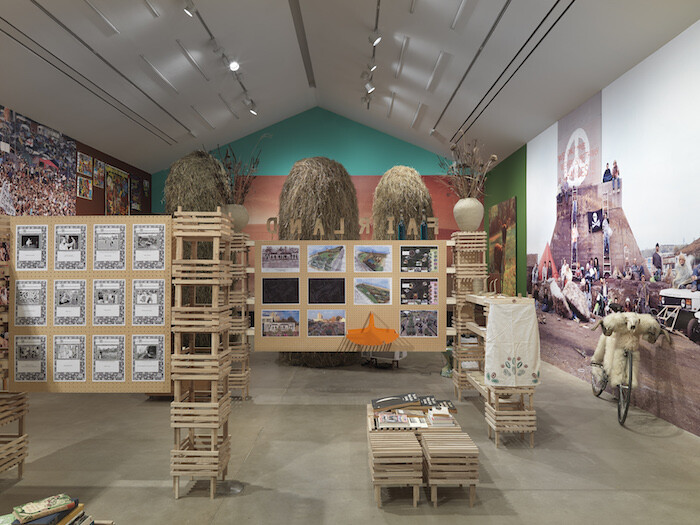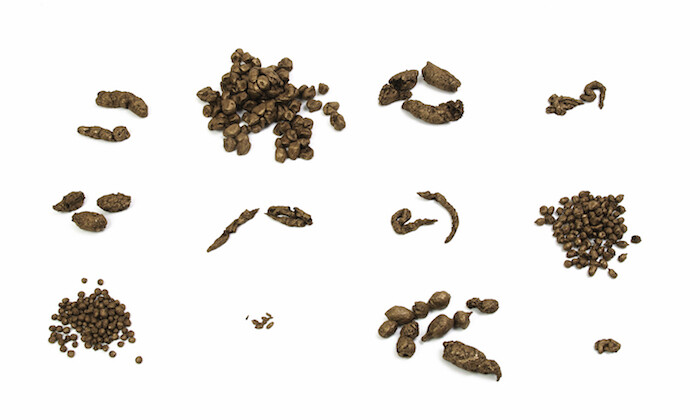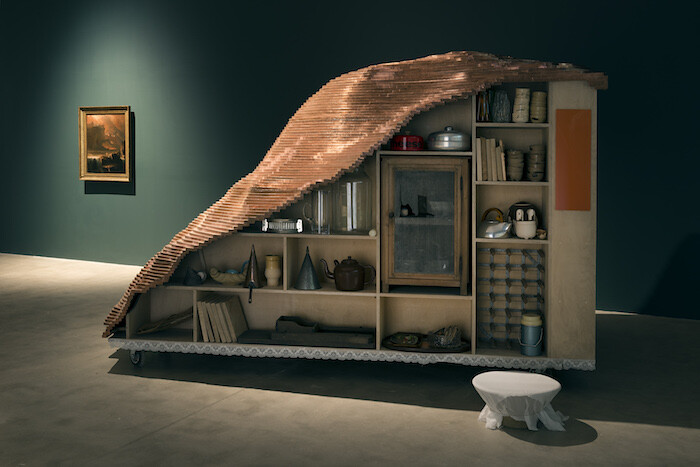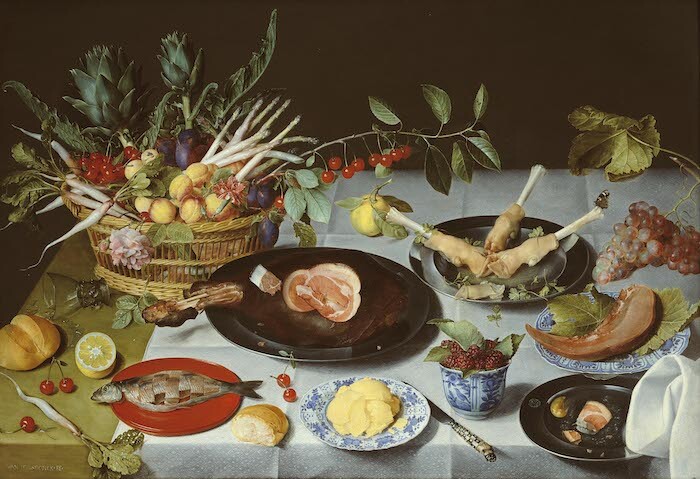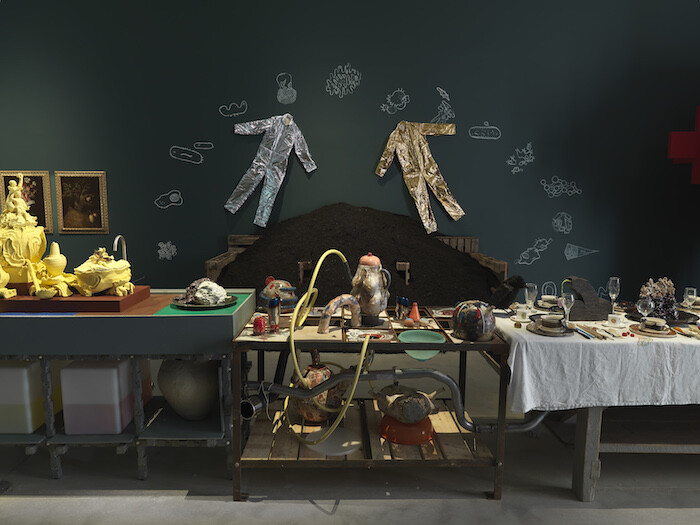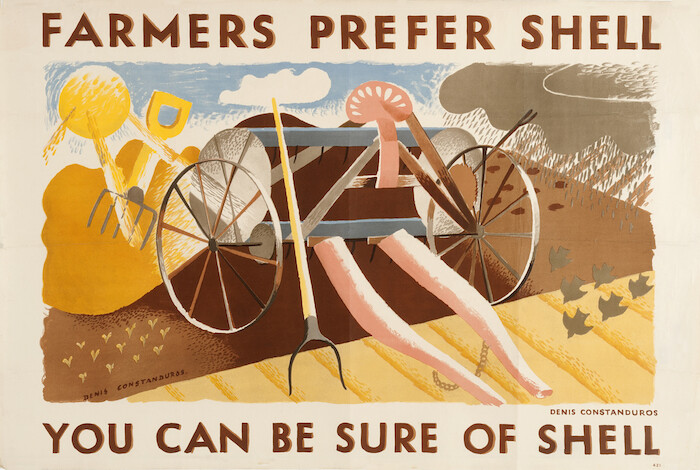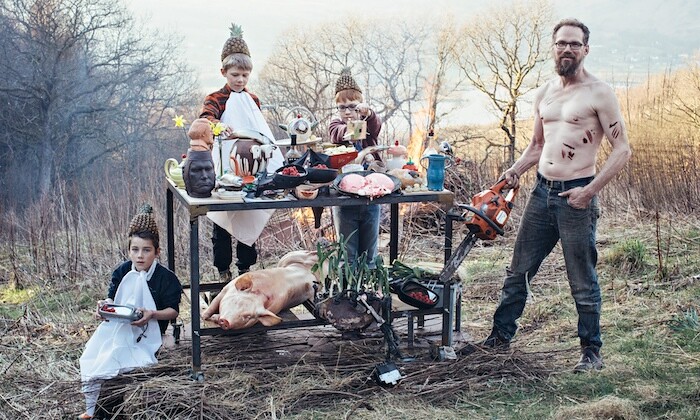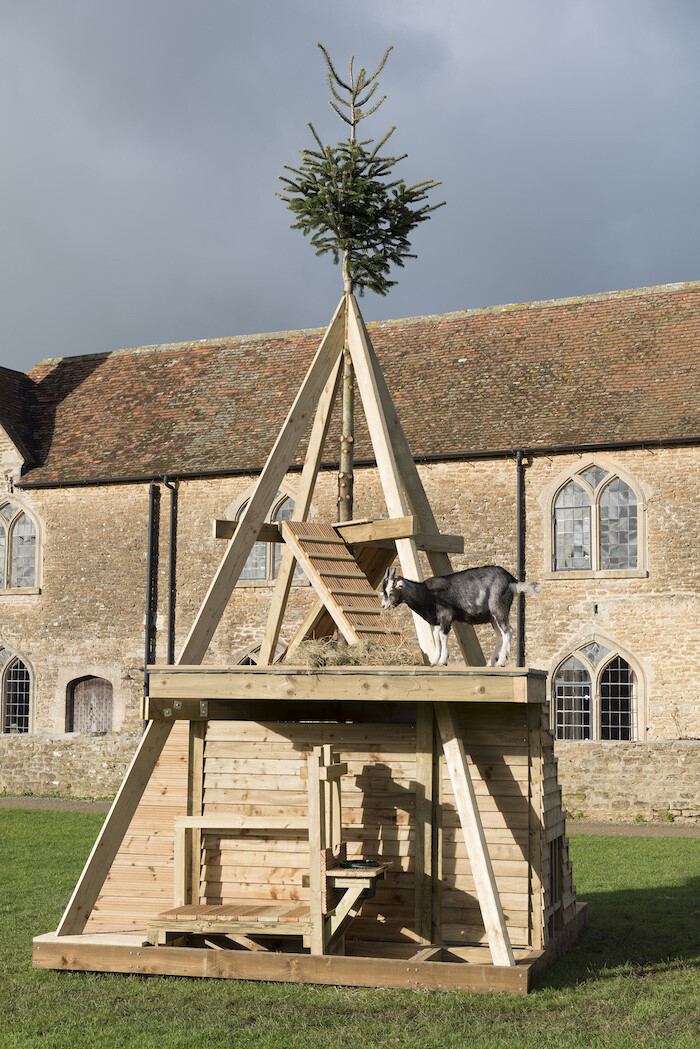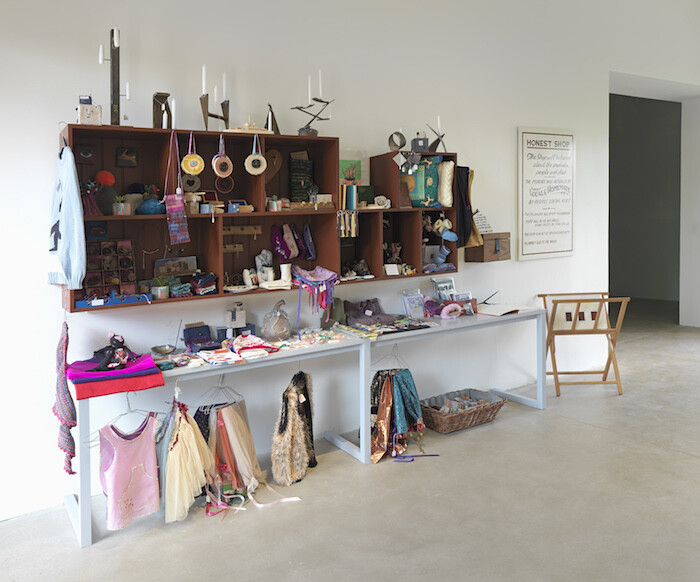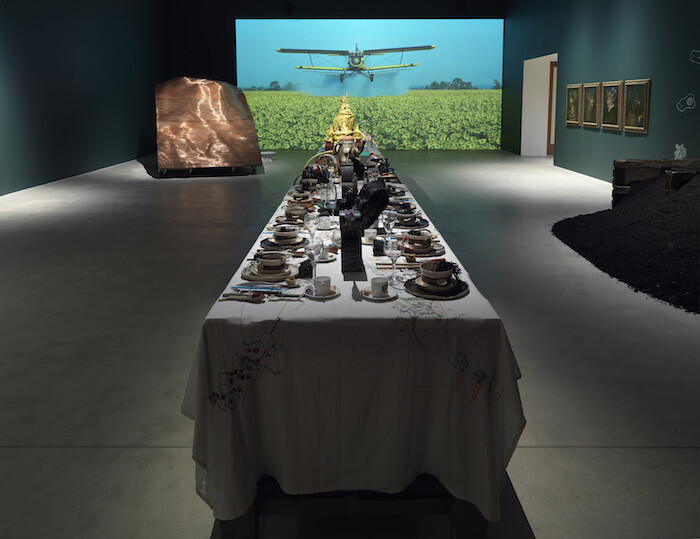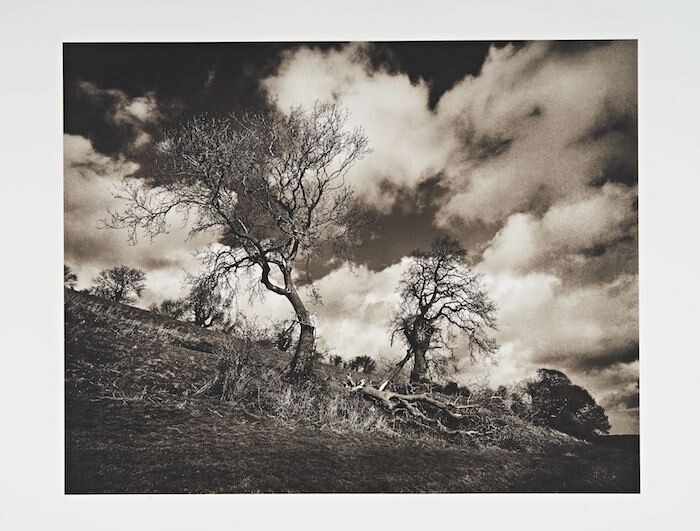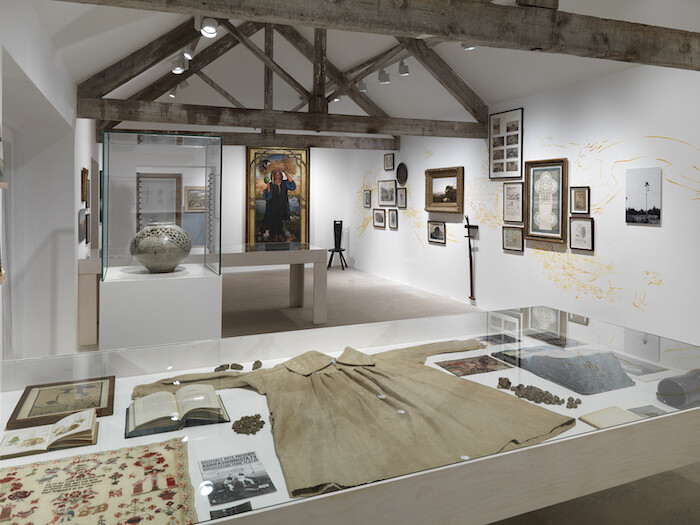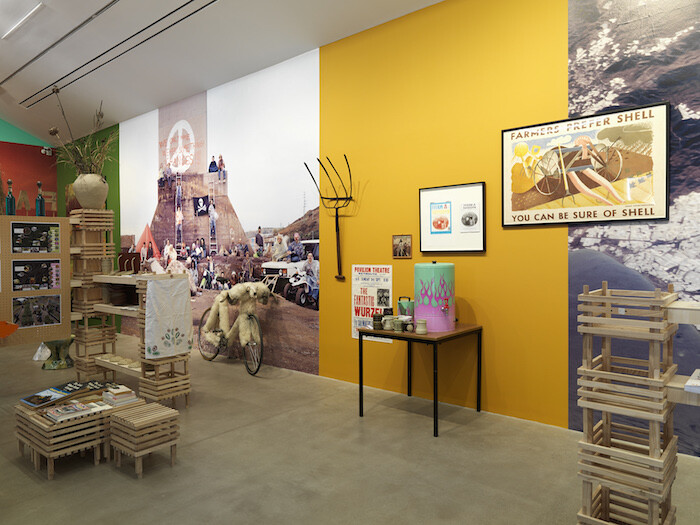To shit on a book—surely only an animal could do such a thing? In a former farm building, now home to Hauser & Wirth Somerset, lies an early edition of a book by Mark Twain: A Yankee at the Court of King Arthur (1889), a satire of medieval European chivalry told through the eyes of a nineteenth-century Connecticut engineer named Hank. On the left-hand page is an annotated diagram of a tree, its roots taking nourishment from the “soil of common sense.” On the right-hand page, Twain’s text advocates something universally human: “A man is a man, at bottom… even the Russians; plenty of manhood in them—even in the Germans—if one could but force it out.”
Weighting the pages open and obscuring some of the text is a pair of slender turds made from gleaming bronze. It’s unclear exactly what creature might have left them—my guess is a pine marten. They’re from “British Mammal Shits” (2012), Marcus Coates’s series of bronze casts of the droppings of foxes, otters, hedgehogs, and other animals. If Twain is emphasizing a shared humanity against the differences accentuated by the rising nationalism of the late nineteenth century, then Coates—with a sense of absurdity characteristic to his work—seems to be drawing analogies between human divisions and those of other mammals. After all, humans are not the only animals to display regional variations or engage in territorial disputes.
It’s unclear why these little turds have been placed atop Twain’s book. Maybe it’s simply a pun on the references in the novel to “bottom” and “force it out.” It is one of many moments of potentially productive confusion that recur throughout “The Land We Live In – The Land We Left Behind,” curated by Adam Sutherland, director of Grizedale Arts, an organization in the Lake District that champions art as a tool for social change. The exuberance and length of the title—an old migrant workers’ toast—sets the tone for a survey exhibition that explores “the contradictory nature of society’s relationship to the rural.” Sprawling across five gallery spaces and out into the courtyard and grounds, it is at once joyous and overwhelming.
The exhibition, and its detailed accompanying booklet, features over 200 works. Live projects involve cheesemaking, aquaponics, and a goat pavilion. Arranged on the walls are William Blake etchings, a John Ruskin self-portrait, four faces by Giuseppe Arcimboldo, and the lavish Still Life of a laid Table, with Plates of Meat and Fish and a Basket of Fruit and Vegetables by Jacob van Hulsdonck painted circa 1615, a period when huge value was placed on produce, if not the labor that produced it. Also on display are books and ceramics, pamphlets and postcards, quilts and banners, a tea towel, a copper tray, even an old smock in a vitrine. (This latter work could be read as a metonym for Hauser & Wirth Somerset itself, in which a series of old, functional farm buildings are placed in a new aesthetic context.) Many pieces come from Grizedale’s own collection; others are on loan from many different sources. A map of the farm roots the exhibition locally, while works from Italy, Japan, and Poland gesture toward an international outlook. Kate Greenaway’s watercolor, Study for Rock, Moss and Ivy (1885), is a particular highlight: not just a portrait of a rock that Ruskin gave her, but its own world within a world, an entire landscape of grays and green.
If there is a recurring thread, it is the making-grand of overlooked rural practices, an elevation of the humble. A pair of plough pieces (ca. 1900s) from the collection of local cheesemaker Richard Hollingbery form pillars at the threshold between two galleries; the set of four black-and-white photographs by Paul McCarthy (Use a Shovel to Throw Dirt in the Air, 1972) find beauty in the act of shoveling earth; while Don McCullin’s black-and-white photograph of a damaged local tree (Broken Tree, near Bruton, 2016) could be read as a metaphor for some mighty, unspecified tragedy. In the final gallery are several projects from Phytology, a medicinal arts garden in east London. Talya Baldwin has produced botanical illustrations of weeds using a biro found on site by artist Ellie Doney. Doney’s reclaimed detritus (Of Lost and Found, 2017) also includes an alphabet card, which she describes as “home, and dinner, for a constellation of snails.” That little phrase evokes the exhibition’s main thrust: that even the lowliest place (or work of art) can serve a multitude of overlapping functions.
Exhibitions on the subject of “nature” are often either myopically apolitical or depressingly apocalyptic. But Sutherland ploughs a different furrow. In celebrating multiple relations to the land—from the Luddites to the Women’s Institute, from Beatrix Potter to Grayson Perry—no generalized human “we” emerges that could simplistically be blamed for industrialized farming, climate change, or the Anthropocene. Rather than yet another critique of a dominant discourse, “The Land” forms a broad-minded celebration of alternatives and oppositions. It opens multiple spaces for different ways of thinking, working, living, and being. It shows that people—and animals—have always sniffed out and trodden their own paths through the world; that small is not meaningless; that temporary does not mean failure; and that, more often than not, shit is complicated.
